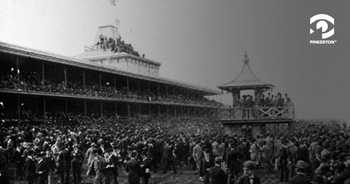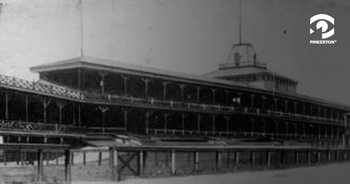The Battle at Gravesend was perhaps the event that earned the Pinkertons immortality in the horse racing world. Around 1880, the Pinkertons established the Pinkerton Racing Services in conjunction with the Brooklyn Jockey Club and the larger racing associations in the United States and Canada. They were the watchful “Eye” protecting the tracks against all manner of pickpockets, touts, louts, swindlers, and thieves. But the Battle at Gravesend was against none of these. It was, rather, the most unforgettable turf war in racetrack history.
The battle began in the spring of 1891 when the Brooklyn Jockey Club — owners of the three racetracks in Brooklyn including Gravesend — raised the rates for the privilege of receiving race odds and results directly from the track via Western Union wire to $4,000 per day. The New York Syndicate, who ran the poolrooms where most of the betting was done, countered with $2,500. The club refused the counter and refused to continue to allow access to the information.
The Syndicate replied, “Try to stop us.”
And that’s when the Pinkertons were called in.
The Syndicate moved their Western Union operators from inside the track and set up outside the gates so their leg men could easily provide race information. The Pinkertons, on behalf of the Jockey Club, stopped this by barring anyone from entering or leaving the track’s front gates from 20 minutes before the first race until after the last race of the day.
Unfazed, the Syndicate placed runners in the grandstands with a supply of slit tennis balls, pencils, and notepads who were instructed to place race information inside the balls and toss them over the fence. The Pinkertons countered by ceremoniously escorting out of the park every ball tosser “by the seat of their pants.”
The Syndicate then offered $25 to anyone who threw out the first ball with the results at the end of each race. The air was filled with tennis balls as racetrack patrons furiously scribbled down information and tossed their balls over the fence. Not to be defeated, the Pinkertons got in on the action, except they filled tennis balls with wrong winners, driving the New York poolrooms into a frenzy. For the remainder of the afternoon, it was a game of cat and mouse, toss and swat, information and disinformation, and on this note of hilarity the spring meet ended.

They may have won the spring battle, but the war continued
It was Pinkerton’s vigilance that signaled the end of the war. Robert, who was at the track every day to monitor the skirmishes, uncovered the Syndicate’s most ingenious plan.
When the news reached Robert Pinkerton, head of the eastern branch of the Agency, he brought in carpenters to build a 50' fence to block the Syndicate’s view. The Syndicate, in turn, built an even taller tower on top of the cupola — with a crow’s nest where spotters were strapped in. The Pinkertons raised the fence to 60', but when a strong breezed kick up, the carpenters dropped their tools and clung to the rickety assembly for safety. Ever security minded, Pinkerton abandoned the fence and instead erected tall poles and stretched canvas between them.
The Syndicate continued its pursuit by renting rooms and houses all around the track and sending in men with elaborate semaphore systems — a system quickly discontinued when the crowds began making false signals to confuse spotters.
“In this mad war,” it was inevitable that carrier pigeons would be introduced, Pinkerton warned his agents. And they were. Men had the birds inside their coats, in top hats or bowlers, and ladies in their bustles. A noted female pickpocket was hired to use her specially made dress to smuggle in a cage of 17 pigeons, but she was nabbed at the gate. In addition to stopping the pigeon handlers at the gate, Robert also sent up flocks of birds with phony race results, which again “created havoc in the poolrooms,” wrote historian James Horan.
But what won the war was when Pinkerton, who was at the track every day to monitor the skirmishes, uncovered the Syndicate’s most ingenious plan.
A barouche carriage carrying well-dressed men and women arrived at the track every day for three days. In between the races, the men and women would stroll back to their carriage for a bite to eat from their picnic basket. Always the intrepid detective, Pinkerton had noticed one of the men wearing what appeared to be a somewhat large hat. Pinkerton followed the man to the carriage and grabbed his hat. In it, he found an electric bulb attached to a battery and telegraph key. The carriage driver had used the setup to relay results to a telegrapher stationed on the top floor of a nearby house.
With that, the Battle at Gravesend ended.

Robert Pinkerton assassination attempt
Fifteen years later, amid another—or ongoing—battle between the Brooklyn racetrack owners and the syndicate who ran the poolrooms and betting parlors in New York, news agencies from around the country reported that poolroom agents attempted to assassinate Robert Pinkerton.
Just after the finish of the Springs Stakes at Sheepshead Bay Racetrack on July 4, 1906, a man standing close to the judge’s stand suddenly dropped to the ground crying out, “I’m shot.”
Pinkerton, who was standing at the rail, ran to the injured man and saw blood flowing from a wound on the right side of his head. The man, John T. Fowells from Buffalo, NY, was immediately taken to the Emergency Hospital in Coney Island. The attending physician stated that Fowells was fortunate. His examination of Fowells, and his straw hat, showed a bullet had traveled in a sharply downward direction passing through the crown and out through the brim, grazing the side of his head. He was treated and released.
The story, however, spread like wildfire. Most newspapers reported with sensation that Pinkerton himself had been the object of an assassin's bullet and that the bullet came from the Syndicate’s neighborhood headquarters just beyond the track’s backstretch, a quarter of a mile away.
“It was believed that the disgruntled poolroom employee who possibly fired the shot at Pinkerton tried to get even with his enemy…” the New York American and Buffalo Courier both reported.
Pinkerton was the first to laugh at the assassination attempt and believed that the bullet had been fired by some Fourth of July celebrant outside the track.
“How some of the papers get such a garbled account of the affair is beyond me,” Pinkerton stated. “I was standing 15 or 20 feet away from Mr. Fowells when he fell.”
Pinkerton continued, “It seems incredible that anyone who was such a bad shot as to go as wide as that would have undertaken such an attempt if the bullet was aimed at me. Then neither I nor my men can find anyone who heard any report. The suggestion that the shot came from one of the houses nearly a quarter of a mile away from which the poolroom men tried to overlook the track at the beginning of the meeting is too absurd for consideration. No one is going to try to pick a man off in a crowd at a distance of a quarter of a mile with a revolver, and though the bullet was not found, the physicians tell me they are satisfied it came from a small pistol, probably one of .22 caliber.”
The police later determined that the assassination attempt was real. A gunman had been hired and for days stalked Pinkerton at the racetrack. The gunman took his shot at the exact moment the detective turned his head away from the track, and Fowells was struck. And while the doctors initially believed the bullet merely grazed Fowells’ scalp, they later removed a rifle slug from under his skin. Pinkerton remained unfazed.
Horan, James. The Pinkertons: The Detective Dynasty That Made History, pp 487-488.





